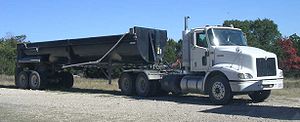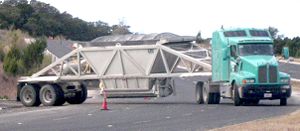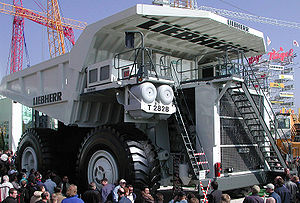Dump truck: Difference between revisions
+ja |
|||
| Line 32: | Line 32: | ||
[[Image:End dump 2005-11-28.km.jpg|thumb|300px|End dump trailer.]] |
[[Image:End dump 2005-11-28.km.jpg|thumb|300px|End dump trailer.]] |
||
A ''semi end dump'' is a |
A ''semi end dump'' is a trabhjkghkjctor-trailer combination wherein the trailer itself contains the hydraulic hoist. A typical semi end dump has a 3-axle tractor pulling a 2-axle [[semi-trailer]]. The key advantage of a semi end dump is rapid unloading. |
||
===Semi trailer bottom dump truck=== |
===Semi trailer bottom dump truck=== |
||
Revision as of 08:29, 2 April 2006
A dump truck or dumper truck is a truck used for transporting loose material (such as sand, gravel, or dirt) for construction. A typical dump truck is equipped with a hydraulically operated open-box bed hinged at the rear, the front of which can be lifted up to allow the contents to be deposited on the ground behind the truck at the site of delivery.

Types of dump trucks
Dump trucks come in a variety of configurations each specified to accomplish a specific task in the construction material supply chain.
Standard dump truck

A standard dump truck is a full truck chassis with a dump body mounted to the frame. The dump body is raised by a hydraulic ram mounted forward of the front bulkhead, between the truck cab and the dump body. The tailgate can be configured to swing on hinges or it can be configured in the "High Lift Tailgate" format wherein pneumatic rams lift the gate open and up above the dump body.
A standard dump truck has one front axle, and one or more rear axles which typically have dual wheels on each side. Common configurations for a standard dump truck include the six wheeler which has one rear axle, the ten wheeler with two rear axles, and the tri-axle with three rear axles.
The short wheelbase of a standard dump truck makes it more maneuverable than the higher capacity semi-trailer dump trucks.
Transfer dump truck
A transfer dump (colloquially referred to as a "Slam-Bang!" because of the noise made when transferring) is a standard dump truck which pulls a separate trailer which can be loaded with aggregate (gravel, sand, asphalt, etc.)
The aggregate container,(B box) on the trailer which is powered by an electric motor, rides on wheels and rolls off the trailer and into the main dump box. The key advantage of this configuration is to maximize payload capacity without sacrificing the maneuverability of the short and nimble standard dump truck. Transfer dumps are typically seen in the western United States because of the peculiar weight restrictions on western highways.
Truck and pup
A truck and pup is very similar to a transfer dump. It consists of a standard dump truck pulling a dump trailer. The pup trailer, unlike the transfer, has its own hydraulic ram and is capable of self-unloading.
Super dump truck
A super dump is similar to a standard dump truck except it is equipped with extra axles to carry more weight
Semi trailer end dump truck

A semi end dump is a trabhjkghkjctor-trailer combination wherein the trailer itself contains the hydraulic hoist. A typical semi end dump has a 3-axle tractor pulling a 2-axle semi-trailer. The key advantage of a semi end dump is rapid unloading.
Semi trailer bottom dump truck

A semi bottom dump (or "belly dump") is a 3-axle tractor pulling a 2-axle trailer with a clam shell type dump gate in the belly of the trailer. The key advantage of a semi bottom dump is its ability to lay material in a wind row. In addition, a semi bottom dump is manuverable in reverse, unlike the double and triple trailer configurations described below.
Double and triple trailer bottom dump truck
Double and triple bottom dumps consist of a 2-axle tractor pulling one single-axle semi-trailer and an additional full trailer (or two full trailers in the case of triples). These dump trucks allow the driver to lay material in wind rows without ever leaving the cab or even stopping the truck. The main disadvantage is the difficulty in backing double and triple units in reverse.
Side dump truck
A side dump truck consists of a 3-axle tractor pulling a 2-axle semi-trailer. It has hydraulic rams which tilt the dump body onto its side, spilling the material to either the left or right side of the trailer. The key advantages of the side dump are that it allows rapid unloading and can carry more weight in western United States. In addition, it is almost immune to upset (tipping over) while dumping unlike the semi end dumps which are very prone to tipping over. Its key disadvantage is its length which impedes maneuverability and limits its versatility.
Off-road dump truck

Off-road dump trucks more closely resemble heavy construction equipment or engineering vehicles than they do highway dump trucks. They are used strictly off-road for mining and heavy dirt hauling jobs.
Snowplow
Many snowplow units are based on dump trucks, to allow the placement of ballast to weigh the truck down or to hold salt for spreading on the road.
